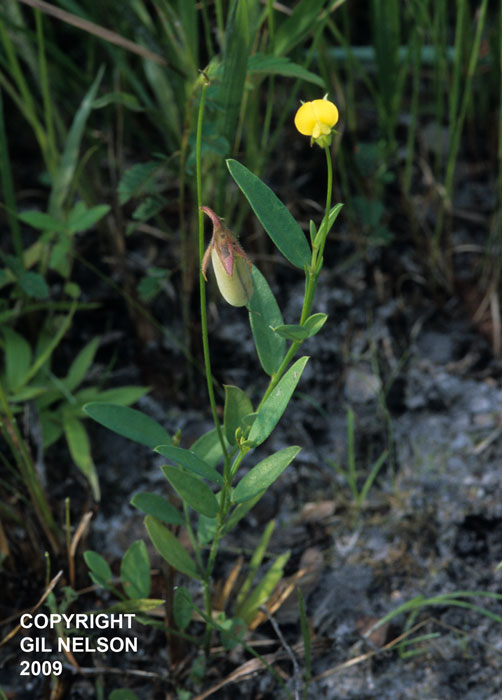Crotalaria purshii
| Crotalaria purshii | |
|---|---|

| |
| Photo by Gil Nelson | |
| Scientific classification | |
| Kingdom: | Plantae |
| Division: | Magnoliophyta - Flowering plants |
| Class: | Magnoliopsida – Dicotyledons |
| Order: | Fabales |
| Family: | Fabaceae ⁄ Leguminosae |
| Genus: | Crotalaria |
| Species: | C. purshii |
| Binomial name | |
| Crotalaria purshii DC. | |

| |
| Natural range of Crotalaria purshii from USDA NRCS Plants Database. | |
Common names: Pursh's rattlebox; coastal plain rattlebox
Contents
Taxonomic notes
Synonyms: Crotalaria purshii var. purshii; C. purshii var. bracteolifera Fernald
Varieties: none
Description
The Crotalaria genus, in general, are annual or perennial herbs or shrubs. The leaves can be simple or palmately 3-7 foliolate where the stipules are either lacking or are varying from minute to large and conspicuous and the leaflets are estipellate. The flowers are papilionaceous and are usually in terminal racemes but can but solitary. The bracts are subtending the pedicels are small to foliaceous, caduceus to persistent; the bracts are paired, minute to large borne on the pedicel or on the base of the calyx. The calyx is campanulate. The petals are yellow or yellow with purple streaks, they're rarely purple or blue; standard usually exceeding the wing and keel petal. There are 10 stamens, they are monadelphous, filaments of two lengths, the longer with small, subglobose anthers and the shorter with larger, linear anthers. The legume is inflated, few-many seeded, globose to more typically oblong-cylindric, sessile or rarely stalked.[1]
Specifically, for Crotalaria purshii, the plant is a perennial herb, growing up to 2-5 dm tall. It is densely appressed pubescent. The leaves are simple, the median and upper leaves are mostly linear to lanceolate, growing 3-6 (8) cm long, and 4-10 mm wide, the lower leaves are oblong to spatulate, growing 2-3 cm long, and 6-15 mm wide. The stipules of the the median and upper leaves are inversely sagittate decurrent 1/2 the length of the internode or more. The peduncle grows to 3-12 cm long, and is 3-6 flowered. The calyx is closely subtended by 2 linear, appressed bractlets, growing 4-6 mm long. The petals are yellow in color, and are equal or longer than the calyx. The legume is glabrous, oblong-cylindric, growing 2.5-4 cm long, and ca. 1 cm in diameter.[1]
Distribution
Ecology
It is a legume.[2]
Habitat
It can live in temperatures ranging from 10 to 28 degrees Celsius with an average of 115 cm of rain annually.[3] It appears in a range of light conditions, from semi-shade to full sun, and a variety of mostly sandy soil types, including drying loamy sand, moist sand, clayey soil, peat, and loose sand.[4]
Specific habitat includes grassy pineland communities[2] such as loblolly pine communities,[3] pine-scrub oak-palmetto woodlands, coastal dunes, and hillside bogs.[4] It also can be found in disturbed areas, including roadsides and clobbered flatwoods.[4]
Associated species include Baptisia simplicifolia, Liatris, Vernonia, Pityopsis, Eupatorium mohrii, E. rotundifolium, Pinus palustris, Quercus marilandica, Andropogon, Panicum, Vaccinium, Aristida stricta, Sabal minor, Ilex glabra, and others.[4]
Phenology
Crotalaria purshii was observed flowering in sandhill and flatwood forests.[5]
The species has been observed flowering April through October with peak inflorescence in May, and fruiting has been observed in May through October.[6][4]
Seed dispersal
This species is thought to be dispersed by ants and/or explosive dehiscence. [7]
Fire ecology
This species is fire tolerant and occurs in burned areas.[4]
Use by animals
It is consumed by bobwhite quail.[2]
Conservation and management
Cultivation and restoration
Photo Gallery
References and notes
- ↑ 1.0 1.1 Radford, Albert E., Harry E. Ahles, and C. Ritchie Bell. Manual of the Vascular Flora of the Carolinas. 1964, 1968. The University of North Carolina Press. 584-5. Print.
- ↑ 2.0 2.1 2.2 Graham, E. H. (1941). Legumes for erosion control and wildlife. Washington, USDA
- ↑ 3.0 3.1 Miller, J. H. and K. V. Miller (1999). Forest plants of the southeast, and their wildlife uses Champaign, IL, Southern Weed Science Society.
- ↑ 4.0 4.1 4.2 4.3 4.4 4.5 Florida State University Robert K. Godfrey Herbarium database. URL: http://herbarium.bio.fsu.edu. Last accessed: June 2014. Collectors: Harry E. Ahles, Loran C. Anderson, Grafton Anding, Wilson Baker, M.L. Bomhard, R. S. Campbell, Andre F. Clewell, Richard R. Clinebell II, D. S. Correll, Delzie Demaree, Robert K. Godfrey, J. Haesloop, A. Johnson, Lisa Keppner, Ed Keppner, R. Komarek, R. Kral Paul C Lemon, M. Jenkins, Sidney McDaniel, Thomas E. Miller, John B. Nelson, R. A. Norris, C.K. Pearse, A. B. Pittman, H. R. Reed, Annie Schmidt, Kenneth Lee Tyson, and Jean Wooten. States and Counties: Alabama: Baldwin, Conecuh, Geneva, and Washington. Florida: Bay, Calhoun, Dixie, Duval, Franklin, Gadsden, Gulf, Lee, Leon, Liberty, Madison, Santa Rosa, Sarasota, Wakulla, Walton, and Washington. Georgia: Berrien, Coffee, Grady, Seminole, Thomas, and Tift. Louisiana: Washington. Mississippi: George, Jackson, and Pearl River. North Carolina: Sampson. South Carolina: Dorchester and Lee.
- ↑ Platt, W. J., Gregory W. Evans, and Mary M. Davis (1988). "Effects of Fires Season on Flowering of Forbs and Shurbs in Longleaf Pine Forests." Oecologia 76(3): 353-363.
- ↑ Nelson, G. PanFlora: Plant data for the eastern United States with emphasis on the Southeastern Coastal Plains, Florida, and the Florida Panhandle. www.gilnelson.com/PanFlora/ Accessed: 8 DEC 2016
- ↑ Kirkman, L. Katherine. Unpublished database of seed dispersal mode of plants found in Coastal Plain longleaf pine-grasslands of the Jones Ecological Research Center, Georgia.